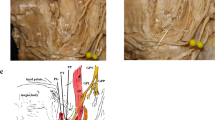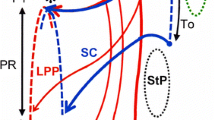Abstract
Purpose
The pharyngeal muscles are innervated by the glossopharyngeal and vagus nerves. However, their spatial interrelationships with the innervating branches have been unclear. This study examined the pharynx to elucidate their precise relationships for the anatomical evidence of the functional diagnosis.
Method
The muscles and nerves were dissected under a binocular microscope in 44 sides of 22 cadavers fixed with 8% formalin.
Results
The pharyngeal muscles overlapped each other, and the pharyngeal constrictors sometimes linked to adjacent muscles. The uppermost part of the superior constrictor arose from the soft palate, and sometimes contained the fibers attaching to the petrous part of the temporal bone. Anomalous bundles were frequently found between the superior and middle constrictors and the stylopharyngeus. The stylopharyngeus and the glossopharyngeal part of the superior constrictor were innervated by the glossopharyngeal nerve, which occasionally penetrated the stylopharyngeus. The pharyngeal plexus not only spread onto dorsolateral surface of the pharynx but also sent branches between the constrictors. The plexus supplied the superior constrictor and salpingo- and palatopharyngei from their dorsal surface and the middle and inferior constrictors from their ventral and dorsal surfaces. The inferior constrictor received additional innervations from the laryngeal nerves.
Conclusions
The innervations pattern suggests that the pharyngeal muscles comprise four groups: the first innervated by the glossopharyngeal nerve, the second and third by the pharyngeal plexus, and the fourth by the plexus and the laryngeal nerves. The stylopharyngeus descends between the second and third groups, and its penetration may cause the anomalous bundles between them.





Similar content being viewed by others
References
Drake RL, Vogl W, Mitchell AWM (2005) Gray’s anatomy for students. Elsevier, Philadelphia
Standring S (2005) Head and Neck. In: Standring S, Ellis H, Healy JC, Johnson D, Williams A (eds) Gray’s anatomy, 39th edn. Elsevier Churchill Livingstone, Edinburgh, pp 439–723
DuBrul EL (1988) Sicher and DuBrul’s oral anatomy, 8th edn. Ishiyaku EuroAmerica, St. Louis
Romanes GJ (1981) Cunningham’s textbook of anatomy, 12th edn. Oxford university press, Oxford
Lang IM, Shaker R (1997) Anatomy and physiology of the upper esophageal sphincter. Am J Med 103(5A):50S–55S
Sasaki CT (2000) Understanding the motor innervation of the human cricopharyngeus muscle (Review). Am J Med 108(Suppl 4a):38S–39S
Singh S, Hamdy S (2005) The upper oesophageal sphincter. Neurogastroent Motil 17(Supple 1):3–12
Sivarao DV, Goyal RK (2000) Functional anatomy and physiology of the upper esophageal sphincter (Review). Am J Med 108(Suppl 4a):27S–37S
Larsen WJ (2001) Development of the head and neck. In: Sherman LS, Steven Potter S, Scott WJ (eds) Human embryology, 3rd edn. Churchill Livingstone, New York, pp 351–389
Sadler TW (2004) Medical embryology, 9th edn. Lippincott Williams & Wilkins, Philadelphia
Kitamura S, Nagase Y, Chen K, Shigenaga Y (1993) Nucleus ambiguus of the rabbit: cytoarchitectural subdivision and myotopical and neurotopic representations. Anat Rec 237:109–123
Kitamura S, Nishiguchi T, Ogata K, Sakai A (1988) Neurons of origin of the internal ramus of the rabbit accessory nerve: localization in the nucleus ambiguus. Okajimas Folia Anat Jpn 65:291–301
Kitamura S, Ogata K (1990) An HRP study of location of the rabbit palatopharyngeal motoneurons and peripheral course of their axons. Anat Rec 228:225–229
Kitamura S, Ogata K, Nishiguchi T, Nagase Y, Shigenaga Y (1991) Location of the motoneurons supplying the rabbit pharyngeal constrictor muscles and the peripheral course of their axons: a study using the retrograde HRP or fluorescent labeling technique. Anat Rec 229:399–406
Kitamura S, Ogata K, Sakai A (1988) An HRP study of the central localization of the rabbit stylopharyngeal motoneurons and the peripheral courses of their axons. J Osaka Univ Dent Sch 28:53–61
Van Loveren H, Saunders MC, Cassini P, Keller JT (1985) Localization of motoneurons innervating the stylopharyngeus muscles in the cat. Neurosci Lett 58:251–255
Satoda T, Takahashi O, Murakami C, Uchida T, Mizuno N (1996) The sites of origin and termination of afferent and efferent components in the lingual and pharyngeal branches of the glossopharyngeal nerve in the Japanese monkey (Macaca fuscata). Neurosci Res 24:385–392
Mu L, Sanders I (2007) Neuromuscular specializations within human pharyngeal constrictor muscles. Ann Oto Rhinol Laryn 116:604–617
Shimokawa T, Yi S-Q, Izumi A, Ru F, Akita K, Sato T, Tanaka S (2004) An anatomical study of the levator veli palatini and superior constrictor with special reference to their nerve supply. Surg Radiol Anat 26:100–105
Bergman RA, Thompson SA, Afifi AK, Saadeh FA (1988) Compendium of human anatomic variation: text, atlas, and world literature. Urban & Schwarzenberg, Baltimore
Shimada K, Yokoi A, Ozawa H, Kitagawa T, Tezuka M (1991) Observation of the petropharyngeal muscle in Japanese. Anat Anz 173:193–198
Suzuki HK, Briggs DD, Pyle HR, Walloch BO, Wilson MC (1960) Observations on an unusual case of bilateral platysmo-pharyngeal muscular interconnections in man. Anat Rec 137:93–97
Author information
Authors and Affiliations
Corresponding author
Rights and permissions
About this article
Cite this article
Sakamoto, Y. Classification of pharyngeal muscles based on innervations from glossopharyngeal and vagus nerves in human. Surg Radiol Anat 31, 755–761 (2009). https://doi.org/10.1007/s00276-009-0516-9
Received:
Accepted:
Published:
Issue Date:
DOI: https://doi.org/10.1007/s00276-009-0516-9




